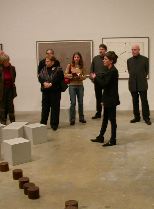 My main reason for going to the members’ walkthrough of the Barry Le Va retrospective at ICA was to hear the artist’s name pronounced. I’d been swinging back and forth between Le Va (ha) and Le Va (hey) all week and my curiosity was an engine propelling me to the museum.
My main reason for going to the members’ walkthrough of the Barry Le Va retrospective at ICA was to hear the artist’s name pronounced. I’d been swinging back and forth between Le Va (ha) and Le Va (hey) all week and my curiosity was an engine propelling me to the museum.
As it turns out I got there too late to hear the surname pronounced, but Libby, who heard it, reported it is Le Va (hey). (image is Le Va, far right, and Curator Ingrid Schaffner, speaking, at the members’ walk-through.)
Now that that’s cleared up, I have not a lot more to say except that the work seems about chaos and order and has at its core a kind of questing to find comfort in an uncomfortable world. (See Libby’s comprehensive post for more.)
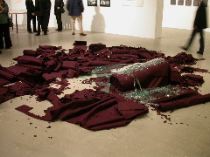
The earlier works with the broken glass, meat cleavers in walls and guns fired at walls are evocations of violence and a world of shattered stability. (left is felt and glass piece)
In a sound piece from the era — installed in the ICA’s ramp but played so loudly that you hear it like rolling thunder in the gallery space downstairs — the artist is heard running full bore and slamming himself into a wall. He does this repeatedly getting more and more bruised in the exercise.
That body slamming piece, like other body art of the time (Chris Burden having himself shot in the arm) were responses to the dark times of Vietnam and the search for meaning at what seemed like the dawn of cultural cynicism. Like “pinch me” moments when the dream is either too good or too bad, they were tests, probably had to be done, and are now, happily, behind us. (image right is the speaker for the body slam sound piece installed in the ramp.)
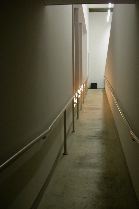
Anyway, Le Va’s other violence works are body art without using bodies. When he shoots a wall or attacks it with meat cleavers, that wall is a body, no matter what architectural framework you want to give it. It’s Le Va’s ability to convey body-ness without producing a corpse or corpus that is unique. It’s high level disassociation achieved with smart choice of materials and with groupings that — in my mind’s eye — evoke community, crowds, animals, grouping and ungrouping and regrouping. What I thought most notable about LeVa’s gun shot piece (where five shots were fired at the ICA wall by a sharp shooter) was that neither Curator Schaffner nor the artist could be there for its “installation.” The level of Sol Lewit phoning it in for what is after all a scary piece (how can you control a bullet? accidents…and ricochets happen all the time) left me wondering. It might have been just a scheduling problem but don’t you think you’d want to be there for the installation of one of the most memorable pieces in your show? As Libby told you, Le Va wielded the meat cleaver himself. And Schaffner was the one who sledge-hammered the glass in the mezzanine.
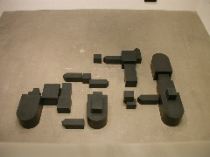
LeVa’s work at bottom is likeable for being about something big — seeking order in a chaotic world. It’s also loveable for its nice juxtapositions of materials (glass and felt; wood and concrete). And, for all its formalist leanings (titles refer to geometry and science and space) the pieces all to my mind convey a level of body-ness and human-ness that I found most reverberant. (image looks down on a floor piece from ICA’s upstairs.)

The artist is great at creating spatial relationships, and there’s a sense of architectural or furniture arranging or chess playing. And the early works have a testosterone-fueled young man’s edginess with their violence and implied chaos and the later works have a calmer, studied disorderliness. I found it all a little poignant and forlorn.
Those blocks of wood and hydrostone that are the later works, they nestle in with each other so nicely. Those cut logs upstairs placed just so next to their concrete neighbors, they’re little neighborhoods; that felt under all that broken glass, it’s trousers, hats, coats and blankets violated by the shards. Everywhere in the work there is separation, hurt and aloneness. (large floor piece in the downstairs)
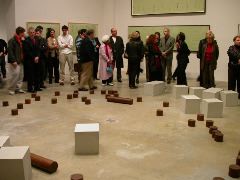
I liked the more recent work best, the big black blocks on the first floor with their casket-like ambiance. In their non-ordered orderliness they seemed to get at some truth about life.
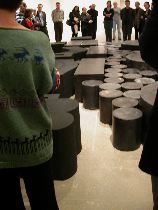
When the artist and Curator Schaffner convened the listeners around the various works to talk about them, the scattered bodies coming together around the scattered or not quite scattered art objects were all kindred spirits.









